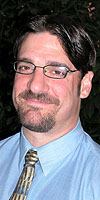|
Subscribe / Renew |
|
|
Contact Us |
|
| ► Subscribe to our Free Weekly Newsletter | |
| home | Welcome, sign in or click here to subscribe. | login |
Environment
| |
 Marc Stiles Real Estate Editor |
March 31, 2005
Real Estate Buzz: Developer wants to LEED with housing
Real Estate Editor
Back in 2002, Ben Kaufman began the quest for a place where he could try out some of the innovative development ideas he had studied for more than 10 years. Now the owner of GreenWorks Realty has found that spot in Newcastle.
Kaufman is planning to build a low-impact development, Newcastle Trails, putting 35 lots on slightly more than six acres he just bought for $700,000.
Part of the team is in place. The Seattle developer has hired Johnston Architects of Seattle and Chris Webb, a Bellingham engineer well known in the Northwest for his passion for sustainable design. Kaufman is looking for a builder who will buy the lots and construct what he hopes will become one of the first LEED-certified residential projects.

Kaufman
|
Contractors who have to ask what LEED means aren't necessarily out of luck. Kaufman says he is willing to work with someone who might not know the tricks to building a community that includes a rainwater garden and other cutting-edge hydrology systems.
Kaufman is looking for someone who's "progressive and kind of adaptable." Someone who understands there's a market advantage to a low-impact development. Someone who gets the benefits of using pervious material for paved surfaces and can grasp the notion of the triple bottom line, which emphasizes social, environmental and economic success.
And he wants to find someone who won't wig out about Kaufman's plans to use a herd of goats, not bulldozers, to remove non-native plants from the wetland buffer.
Goats? He's kidding, right? "No, I'm not," says Kaufman, who starts speaking more quietly, not wanting to make a big deal out of this part of his plan for fear the entire project will be dismissed as wacky.
Kaufman's walking a fine line with Newcastle Trails, and he knows it. "This is a spec project. I'm well aware of that," he says. The homes will not, for instance, have green roofs and other sustainable features that might raise eyebrows.
It's an air-space condo project that will have two communal buildings, one for social gatherings and another where residents can work on crafts and home-improvement projects. That's where he might use alternative building methods, such as rammed-earth or straw-bale construction.
One big hurdle he expects to clear is convincing city officials to permit such a project. To head off any uncertainty, he organized a daylong charette to show municipal planners the site and tell them about his team's preliminary ideas.
"That was absolutely helpful," says Newcastle Associate Planner Salina Lyons. The city's stormwater standards will allow the type of project Kaufman has in mind.
"We feel pretty confident that everybody is aware and knows what we're going to be working with," Lyons says. "At the same time, we've been up front with Ben that we may need to get more information from him."
Newcastle just got GreenWorks' application. Kaufman hopes to get permits this summer, and then start site improvements. Lots should be ready by fall.
Testing the water in Burlington
Panattoni is entering new territory: Burlington. The development company has struck a deal to build a 272,000-square-foot facility there for a private-label bottler, Advanced H2O.
"I've never done anything north of Everett from an industrial standpoint," says Bart Brynestad, the Panattoni partner who opened the company's Puget Sound-area office in Tukwila last year. He says Brian Adams of GVA Kidder Mathews "really brought the deal together."
It's one of a slew of projects Panattoni is pursuing. Among them are:
- An industrial project in the Fryeland Commercial Industrial Park in Monroe, with nine small (8,000 to 12,000 square feet) buildings and some office space. The buildings will be for sale.
- Purchase of what Brynstad calls an industrial "sleeper site" — 20 acres in Auburn at South 277th Street and Highway 167. "I think we'll close in June and build 400,000 square feet." On spec? "Sure, why not," he says. Brynstad now is in the due diligence phase.
- In Federal Way's East Campus neighborhood, Panattoni plans to build four small offices (9,000 to 13,600 square feet). Brynestad concedes the South King County office rental market is softer than the Pillsbury doughboy, but he's building space to sell. He's so confident of the plan that there will be a second phase. "We have another four acres. Once we get the first four done we'll do it again."
Big deal 'more smoke than fire'
Alarm bells went off March 23 when public documents showed Seattle developer and investor Tom Leavitt was involved in 13 property transactions worth more than $39 million.
In most of the deals, Leavitt Investment Co. or braham Kosokoff sold real estate around King County to Leavitt-Wolff Northwest Properties LLC, the record shows.
"All this is a recapitalization of a partnership," Leavitt said. "It was a complicated transaction, but it's really just (a deal) allowing some equity holders to get their equity."
Also, the legal structure of the holding company was changed from a limited partnership to a limited liability company, according to Leavitt, who remains in charge.
"Nothing changes," he said. "(It was) more smoke than fire."
'It's Mr. Koolhaas on line one'
In case you missed it, The New Yorker recently ran a Rem Koolhaas profile with a subtitle asking whether the Dutch architect can "kill the skyscraper?"
It's a dense, 16-pager that talks about how his "audaciously cantilevered" Seattle Central Library has cemented his place on the list of "global starchitects." The article says Koolhaas is determined to make the most of "the afterglow of Seattle," and make his new proposals even bolder.
Interesting, but the real juice is found deeper in the article, where it mentions that Koolhaas' firm — the Office for Metropolitan Architecture — nearly went bankrupt in the mid-90s.
"Some of OMA's troubles can be blamed, associates say, on Koolhaas' brusque style," says writer Daniel Zalewski. Apparently, he will "harangue clients who dither about approving a design or contractors who resist his choice of material." There's a description of Koolhaas "spittle screaming" into his phone.
All of which makes us wonder what it must have been like on the library team.
Got a tip? Contact DJC real estate editor Brian Miller at brian.miller@djc.com or call him at (206) 219-6517.
Previous columns:
- Real Estate Buzz: Rumor mill churns on 2nd & Pine, 03-24-2005
- Real Estate Buzz: Will Seattle ease up on parking?, 03-17-2005
- Real Estate Buzz: Rumors fly over Four Seasons penthouse, 03-10-2005
- Real Estate Buzz: Phasing rail could be boon for builders, 03-03-2005
- Real Estate Buzz: Public Safety Building plan 'revisited', 02-24-2005
- Real Estate Buzz: Ravenhurst ties up Goodwill site, 02-17-2005
- Real Estate Buzz: Retail expansion: fact and fiction, 02-10-2005
- Real Estate Buzz: Maybe the kids can figure it out, 02-03-2005


